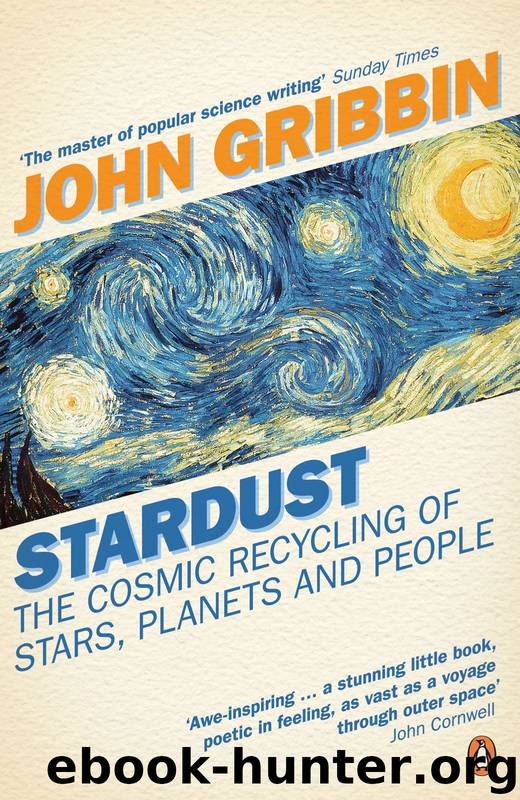Stardust by John Gribbin

Author:John Gribbin
Language: eng
Format: epub
ISBN: 9780141941301
Publisher: Penguin Books Ltd
Published: 2009-07-23T16:00:00+00:00
Chapter 7
Burbidge, Burbidge, Fowler and Hoyle
Fred Hoyle’s long involvement with the search for the origin of the chemical elements began in 1944, when he was twenty-nine years old, and working on radar as part of the British war effort. That year, the job took him on a liaison mission to the USA and Canada. While in the Los Angeles region on official business, he found time on a weekend off to visit the astronomers at the Mount Wilson Observatory, where a discussion with Walter Baade roused his interest in great stellar explosions, novae and (in particular) supernovae. A little later, on the Canadian leg of his journey, Hoyle met up with members of a team of British nuclear physicists based near Montreal. They were ostensibly there to work with the team in Chicago building the world’s first nuclear reactor – but were really, as Hoyle describes it, a ‘listening post’ trying to pick up details of the Manhattan Project (the project to build the first atomic bomb) that the Americans wanted to keep secret, even from their closest allies. There, Hoyle himself picked up enough information about the atomic bomb project to begin to wonder if a supernova explosion might operate in the same way as the technique he surmised (nobody told him; he worked it out from what people were not talking about) was being used by the bomb-makers – an initial implosion forcing material together at extreme temperatures and pressures, thereby triggering an even larger explosion as the material turned inside out and blew itself to bits.
Back in England, Hoyle thought about the problem in his spare time during the winter of 1944/45. He knew that nuclear fusion happened because the energy balance favoured the production of heavy elements from lighter ones, but only up to a point. The arrangement of protons and neutrons as helium nuclei is more desirable, in energy terms, than if the same number of particles are arranged as hydrogen nuclei; carbon nuclei are even more energetically desirable than helium nuclei; and so on. But there is still the old problem of getting positively charged particles such as protons or alpha particles to move fast enough to penetrate the field of electrical repulsion around a nucleus for fusion to occur. Even with the help of the tunnel effect, it is much harder for another positively charged particle to penetrate a nucleus which contains more protons, because there is more electrical charge to overcome. So each step in the process needs a hotter cooking pot, even if the end product represents a more energetically desirable nuclear state.
By this argument, the most desirable nuclei are those of elements such as nickel and iron (‘iron group elements’). Making nuclei heavier than this requires an input of energy, over and above the energy needed to overcome the electrical repulsion. This could be achieved if a star largely made of nuclei of, for example, carbon and oxygen collapsed in upon itself (the implosion), releasing so much gravitational energy that
Download
This site does not store any files on its server. We only index and link to content provided by other sites. Please contact the content providers to delete copyright contents if any and email us, we'll remove relevant links or contents immediately.
Tools of Titans by Timothy Ferriss(8304)
Turbulence by E. J. Noyes(7977)
Secrets of Antigravity Propulsion: Tesla, UFOs, and Classified Aerospace Technology by Ph.D. Paul A. Laviolette(5332)
Astrophysics for People in a Hurry by Neil DeGrasse Tyson(5151)
Room 212 by Kate Stewart(5070)
Design of Trajectory Optimization Approach for Space Maneuver Vehicle Skip Entry Problems by Runqi Chai & Al Savvaris & Antonios Tsourdos & Senchun Chai(5037)
Pale Blue Dot by Carl Sagan(4953)
The David Icke Guide to the Global Conspiracy (and how to end it) by David Icke(4655)
A Journey Through Divination and Astronomy by Publishing Pottermore(4363)
Goodbye Paradise(3761)
Apollo 8 by Jeffrey Kluger(3667)
COSMOS by Carl Sagan(3588)
The Five People You Meet in Heaven by Mitch Albom(3520)
Losing the Nobel Prize by Brian Keating(3518)
How to Read Water: Clues and Patterns from Puddles to the Sea (Natural Navigation) by Tristan Gooley(3431)
Brief Answers to the Big Questions by Stephen Hawking(3392)
How to Read Nature by Tristan Gooley(3290)
The Order of Time by Carlo Rovelli(3162)
A Brief History of Time by Stephen Hawking(2991)
